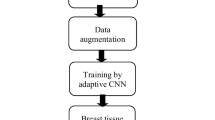Abstract
Artificial intelligence (AI) has emerged as a powerful tool in medical image analysis, revolutionizing the field of radiology and improving diagnostic accuracy and efficiency. Among various imaging modalities, ultrasound imaging is crucial in diagnosing a wide range of medical conditions due to its non-invasive nature and real-time imaging capabilities. However, the scarcity of labeled training data and the challenge of constructing effective learning frameworks pose significant hurdles in developing accurate and robust AI models for ultrasound image analysis. This research paper presents a study conducted on ultrasound images, specifically for breast cancer classification, and focuses on the application of Transfer Learning (TL) using state-of-the-art ImageNet pre-trained models including VGG16, VGG19, ResNet50, ResNet101, and InceptionV3. The study also explores the impact of different fine-tuning strategies on the final classification outcome. Strategies such as freezing 100% of layers, freezing 50% of layers, and scratch fine-tuning by training all layers were implemented along with the same common neural network-based classifier built on top. For reproducibility, publicly accessible datasets were used, namely Mendeley Breast and BUSI datasets. Additionally, a stratified 5-fold cross-validation technique was implemented to evaluate the pre-trained models, and metrics such as Accuracy, Sensitivity, Specificity, Precision, and False Positive Rate (FPR) were computed accordingly. This paper demonstrates the necessity of choosing the appropriate fine-tuning strategy aligned with the pre-trained model used. This can eventually enhance the feature extraction task, thus saving time and effort when implementing such an automatic classification framework for ultrasound images. In the application of breast ultrasound cancer classification, InceptionV3 has been found to be the consistent model across all strategies. Fine-tuning 50% of layers for this model has proved to have better performance.
Access this chapter
Tax calculation will be finalised at checkout
Purchases are for personal use only
Similar content being viewed by others
References
Al-Dhabyani, W., Gomaa, M., Khaled, H., Fahmy, A.: Dataset of breast ultrasound images. Data Brief 28, 104863 (2020). https://doi.org/10.1016/j.dib.2019.104863
Bal-Ghaoui, M., El yousfi Alaoui, M.H., Jilbab, A., Bourouhou, A.: Enhanced ultrasound breast cancer classification based on sparse data and two customized deep learning approaches. IREMOS 15, 82031–82057 (2022)
Guo, R., Lu, G., Qin, B., Fei, B.: Ultrasound imaging technologies for breast cancer detection and management: a review. Ultrasound Med. Biol. 44(1), 37–70 (2018). https://doi.org/10.1016/j.ultrasmedbio.2017.09.012
Kim, H.E., Cosa-Linan, A., Santhanam, N., Jannesari, M., Maros, M.E., Ganslandt, T.: Transfer learning for medical image classification: a literature review. BMC Med. Imaging 22(1), 69 (2022)
Mukhlif, A.A., Al-Khateeb, B., Mohammed, M.A.: An extensive review of state-of-the-art transfer learning techniques used in medical imaging: open issues and challenges. J. Intell. Syst. 31(1), 1085–1111 (2022)
Rodrigues, P.S.: Breast ultrasound image. Mendeley Data 1(10.17632) (2017)
Samee, N.A., Atteia, G., Meshoul, S., Al-antari, M.A., Kadah, Y.M.: Deep learning cascaded feature selection framework for breast cancer classification: hybrid CNN with univariate-based approach. Mathematics 10(19), 3631 (2022)
Yu, X., Wang, J., Hong, Q.Q., Teku, R., Wang, S.H., Zhang, Y.D.: Transfer learning for medical images analyses: a survey. Neurocomputing 489, 230–254 (2022)
Author information
Authors and Affiliations
Corresponding author
Editor information
Editors and Affiliations
Rights and permissions
Copyright information
© 2024 The Author(s), under exclusive license to Springer Nature Switzerland AG
About this paper
Cite this paper
Bal-Ghaoui, M., Alaoui, M.H.E.Y., Jilbab, A., Bourouhou, A. (2024). Transfer Learning Fine-Tuning Strategies for Enhanced Ultrasound Breast Cancer Classification. In: Ezziyyani, M., Kacprzyk, J., Balas, V.E. (eds) International Conference on Advanced Intelligent Systems for Sustainable Development (AI2SD’2023). AI2SD 2023. Lecture Notes in Networks and Systems, vol 904. Springer, Cham. https://doi.org/10.1007/978-3-031-52388-5_12
Download citation
DOI: https://doi.org/10.1007/978-3-031-52388-5_12
Published:
Publisher Name: Springer, Cham
Print ISBN: 978-3-031-52387-8
Online ISBN: 978-3-031-52388-5
eBook Packages: Intelligent Technologies and RoboticsIntelligent Technologies and Robotics (R0)




